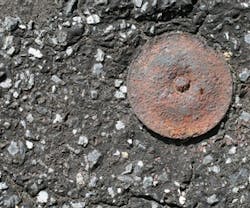Keeping on Top of It
Coal tar built-up roofing has proven superior performance for more than 140 years. However, any material exposed to environmental and human abuse will need attention from time to time. Therefore, be aware of the most commonly encountered maintenance requirements of a coal tar membrane system. Be sure to first determine the type of roof system - coal tar or asphalt - you have.
Compatibility
When using asphalts and coal tars in conjunction with each other, you should note that the two systems' chemical compositions are sufficiently different and will not mix. Asphalt and coal tar can only be used together successfully if recommended procedures are employed. Remember the following four rules:
- Do not try to mix asphalt and coal tar in a kettle; they will not mix.
- Do not use the same tools to apply asphalt and coal tar unless they are clean.
- Do not "gravel-in" a coal tar and felt roof with any asphalt material.
- Repair coal tar roofs with coal tar-based repair compounds and asphalt roof membranes with asphalt-based materials.
Choice of Repair Methods
An important advantage of coal tar is its "cold flow" characteristics, which allows it to self-heal small fractures before more serious damage can occur. Coal tar will change its shape due to the actions of gravity alone. When the rooftop temperature reaches about 70 degrees, coal tar roofing pitch begins to flow. This flow will fill cracks or fissures in the waterproofing barrier and restore the system's integrity.
There are times, however, when there may be physical or deteriorated membrane damage to the roof that needs repair. Three approaches to making repairs include:
- Use traditional hot-applied coal tar pitch with either organic or inorganic reinforcement membranes (typically requires a professional roofing contractor).
- Use cold-applied coal tar repair compounds with fiberglass or polyester reinforcements.
- Use the newest innovation in coal tar roof membrane repair materials - a polymer-modified coal tar membrane. These new products can be hot-mop-applied; cold-applied with a polymer modified cold-applied adhesive/mastic; or hot-air welded, which makes repairs faster, easier, and more economical.
Typical deterioration or damage to a coal tar roof might include:
- Punctures and Ruptures, which are the result of any number of occurrences including falling objects (wind-toppled equipment), dropped objects (tool boxes), fasteners backing out of the deck, ruptured blisters from foot traffic, etc.
- Bare Spots, which are areas that lack surface bitumen and aggregate, leaving the felts exposed to the elements.
- Deteriorated Metal Edge Stripping, which employs metal flanges normally installed over the roofing membrane at the roof edge that are stripped with felts to keep them watertight. Expansion and contraction of the metal will often break the stripping at the joints or laps in the metal. Any rupture or deterioration in the felt stripping could allow water entry beneath the flange and eventually find its way underneath the roof system and into the building.
For more complete specifics on repair and maintenance aspects of coal tar roofs, visit www.buildings.com/Buildingsmag/, access August 2001 Menu and click on Smarter Buildings.
Bob Tomlinson is application technology leader at Honeywell Commercial Roofing, Cary, NC, (800) 221-6490.
